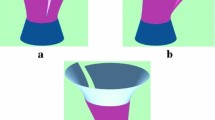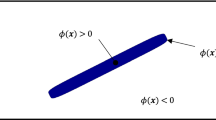Abstract
A model based on the curve-modulation technique is proposed for designing a parametric blend between two parametrically defined surfaces. The modulants are the cross section and the spine curves. The end position and tangency conditions of the cross section are discussed. Its intermediate shape can be left to the designer's choice, and generally depends on the application at hand. Various alternative choices, that fulfill the end conditions are suggested; this provides the flexibility demanded by various applications. The spine is designed as the intersection of two derived surfaces. Two alternative surface derivations are proposed, and both are discussed in some detail with their merits and demerits. The first derivation generates the contact curves automatically and relieves the designer from specifying them; the second one accepts contact curves specified by the designer, and generates the spine accordingly. Both of them are equally important in CAD/CAM and solid modelling applications.
Similar content being viewed by others
References
Agin GJ, Binford TO (1976) Computer description of curved objects. IEEE Trans Comp, C-25:439
Binford TO (1982) Survey of model-based image analysis systems. Int Robotics Res 1(1):18
Bloor MIG, Wilson MJ (1989) Generating blend surfaces using partial differential equations. Computer Aided Design 21 (3):165
Braid IC (1980) Superficial blends in geometric modelling. CAD Group Document No. 105, University of Cambridge Computer Laboratory
Catmull EE, Clark J (1978) Recursively generatedB-spine surfaces on arbitrary topological meshes. Computer Aided Design 10:350
Chiyokura H (1987) An extended rounded operation for modelling solids with free form surfaces. (SIGGRAPH '87 Conf Proc) Computer Graphics 21:249
Chiyokura H, Kimura F (1983) design of solids with freeform surfaces. (SIGGRAPH '89 Conf Proc) Computer Graphics 17:25
Choi BK, Ju SY (1989) Constant radius blending in surface modelling. Computer Aided Design 21:213
Choi BK, Lee CS (1990) Sweep surface modelling via coordinate transformations and blending. Computer Aided Design 22:87
Coons SA (1967) Surfaces for computer aided design of space forms. MIT Project MAC, MAC-TR 41
DePont J (1984) Essays on the cyclide patch. PhD Thesis, University of Cambridge Engineering Department
Doo DWH, Sabin MA (1978) Behaviour of recursive division surfaces near extraordinary points. Computer Aided Design 10:356
Engeli M (1981) Geometric modelling of complex forms with EUKLID. CIRP '81 Conf Proc Manufacturing Systems 10(2)
Farouki RT (1986) The approximation of non-degenerate offset surfaces. Computer Aided Geometric Design 3:15
Faux ID, Pratt MJ (1979) Computational geometry for design and manufacture. Ellis Horwood, Chichester
Filip D (1989) Blending parametric patches. Tran on Graphics 8(3):164
Fajllstrom PO (1986) Smoothing of polyhedral models. (ACM Symposium Conf Proc Computational Geometry 2:226
Forrest AR (1977) On Coons' and other methods for the representation of curved surfaces, Computer Graphics Image Proc 1:341
Forrest AR (1980) The twisted cubic curve: a computer aided design approach. Computer Aided Design 12:165
Hoffman C, Hopcroft J (1985) The potential method for blending surfaces and cornes. Thesis TR 85-699, Cornell University
Hoffman C, Hopcroft J (1986) The geometry of projective blending surfaces. Thesis TR 86-758, Cornell University
Koparkar PA (1984) Computational techniques for processing parametric curves and surfaces. PhD Thesis, University of Bombay
Koparkar P (submitted) Combining subdivision with iterative refinement for detecting intersection of parametric patches
Koparkar PA, Mudur SP (1984) Computational techniques for processing parametric surfaces. Computer Vision, Graphics, and Image Proc 28(3):303
Koparkar PA, Mudur SP (1985) Subdivision techniques for processing geometric objects. In: Nato ASI Series V F 17: Fundamental Algorithms for Computer Graphics. Springer Berlin Heidelberg New York, p 751
Koparkar PA, Mudur SP (1986) Generation of continuous smooth curves resulting from operations on parametric surface patches. Computer Aided Design, 193
Middleditch AE, Sears KH (1985) Blend surfaces for set theoretic volume modelling systems. (SIGGRAPH, 85 Conf Proc) Computer Graphics 19(3):161
Mudur SP, Koparkar PA (1983) Product surfaces and modulated surfaces for 3-D shape representation in computer vision systems. (IEEE Conf Proc) Man, Cybernetics and Society, p 207
Mudur SP, Koparkar PA (1984) Interval methods for processing geometric objects. IEEE Computer Graphics and Applications 4(2):7
Nasri AH (1984) Polyhedral division methods for free-form surfaces. PhD Thesis, University of East Anglia
Nevatia R, Binford TO (1977) Description and recognition of curved objects. Artificial Intelligence 8:77
Rockwood AP, Owen JC (1987) Blend surfaces in solid geometric modelling. Shape Data, Cambridge.
Rossignac JR, Requicha AAG (1984) Constant radius blending in solid modelling. Computers in Mechanical Engineering, p 65
Sanglikar MA, Koparkar P, Joshi VN (1990) Modelling rolling ball blends for computer aided geometric design. Computer Aided Geometric Design 7(1):1
Sanglikar MA, Koparkar P, Joshi VN (submitted): Modelling blends between parametric patches with user specified cross sections, submitted for publication
Sanglikar MA, Koparkar P, Joshi VN (1989) Parametric blends for shape modelling. (IEEE TENCON '89 Conf Proc) Information Technologies for 1990
Sturge DP, Nicholls MS (1982) Developments in DUCT system of computer aided engineering. (23rd MTDR Conf Proc), p 157
Varady T, Vida J, Martin RR (1989) Parametric blending in a boundary representation solid modeller. In: Mathematics of Surfaces 3, Oxford, University Press
Willmore TJ (1949) Differential Geometry. Oxford Press
Woodwark JR (1987) Blends in geometric modelling. In: The mathematics of surfaces II. Oxford University Press, p 255
Zhang D, Bowyer A (1986) CSG set theoretic solid modelling and NC machining of blend surfaces. (Conf Proc ACM Symposium) Computational Geometry
Author information
Authors and Affiliations
Rights and permissions
About this article
Cite this article
Koparkar, P. Designing parametric blends: surface model and geometric correspondence. The Visual Computer 7, 39–58 (1991). https://doi.org/10.1007/BF01994116
Issue Date:
DOI: https://doi.org/10.1007/BF01994116




